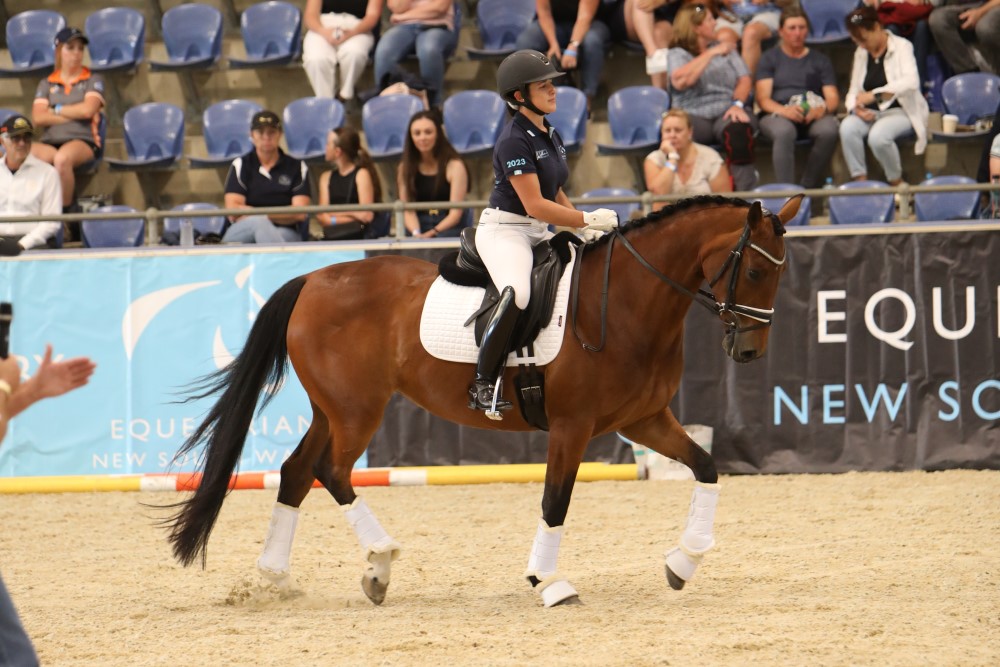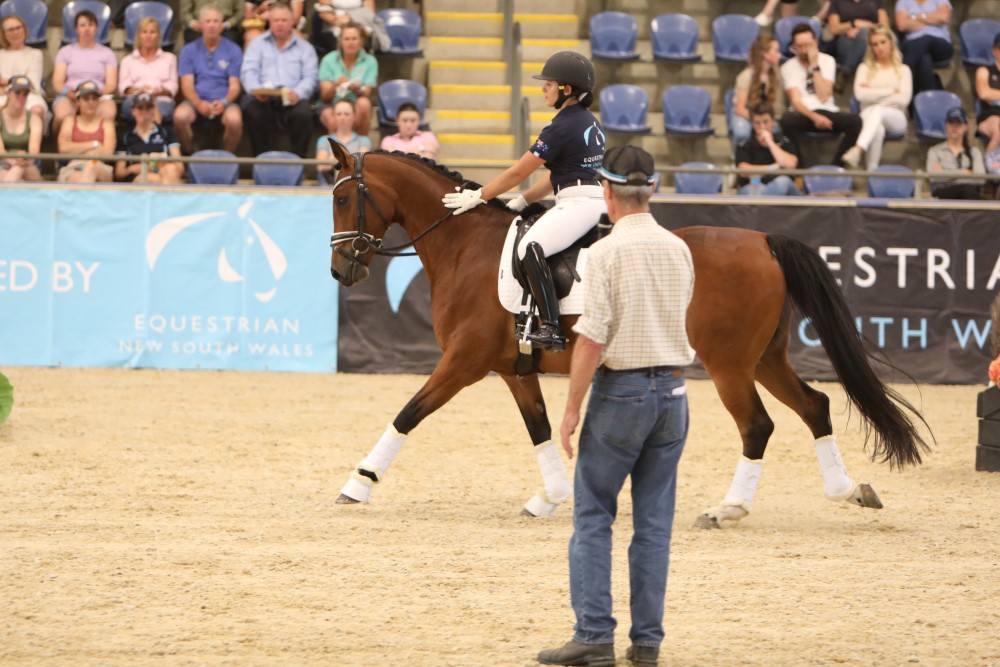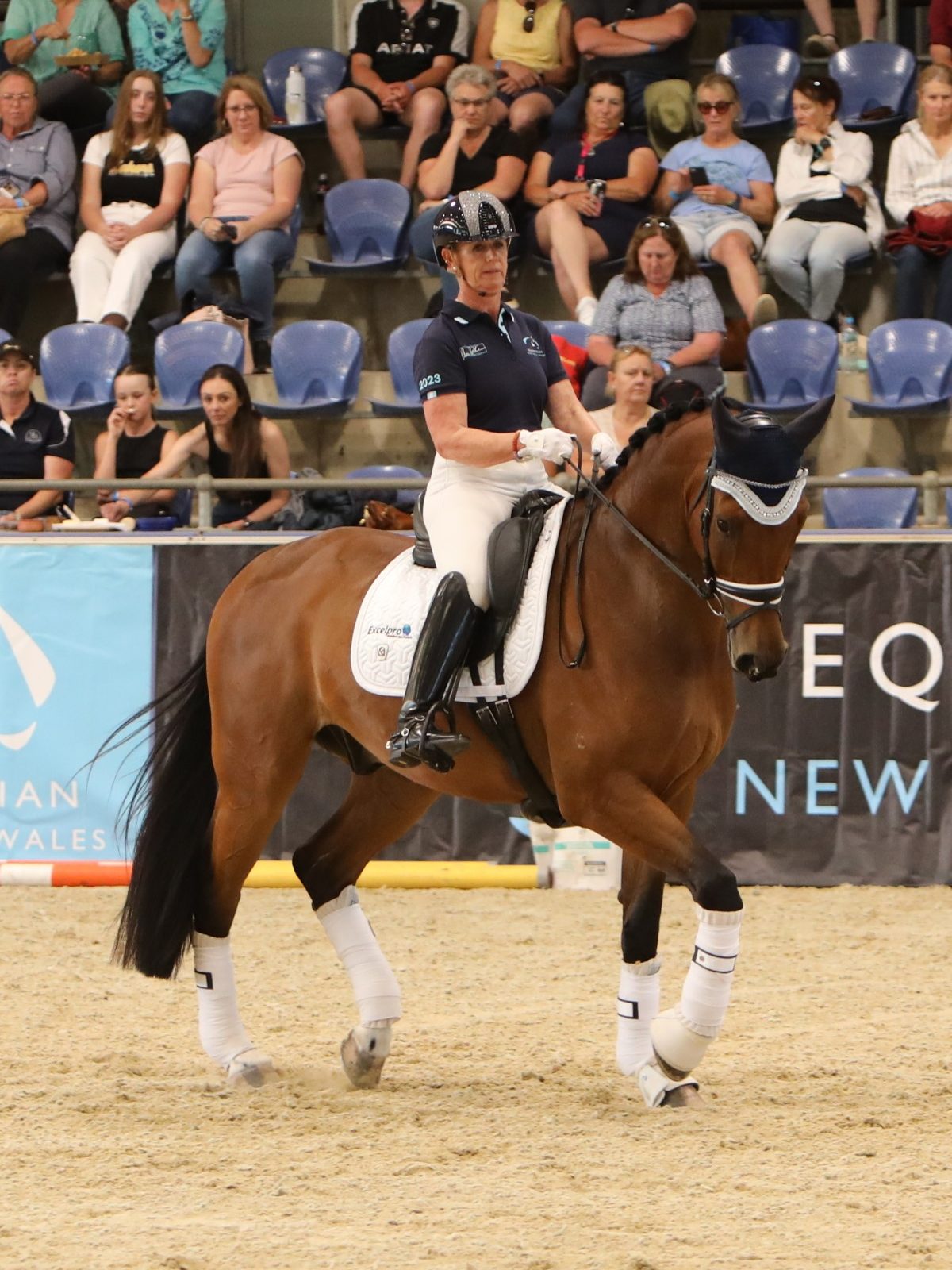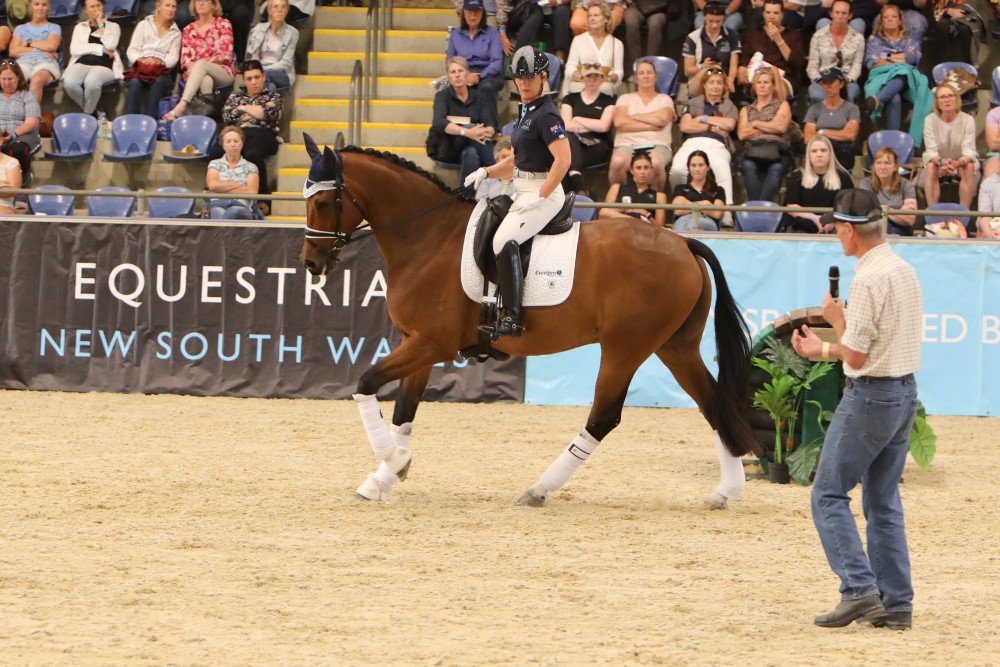With Chris Bartle’s immense success coaching the German and British eventing teams in recent years, plus his past achievements as both an eventer and dressage rider, it was no surprise that his masterclass at Sydney International Equestrian Centre was eagerly anticipated.
Christopher Bartle is a name synonymous with success in the world of eventing in recent years. From 2001 to 2016 he was the National Coach alongside Hans Melzer for Germany’s Eventing Team, a period in which the country claimed two Olympic team gold medals, a team silver and three individual golds. In 2017, Chris became the Performance Coach for the British Eventing Team; to say the British are competitive on the world eventing stage at the moment is an understatement!
Chris was, of course, a successful eventer himself, with 1997 European Championship team gold and a Badminton Horse Trials title (1998 with Word Perfect II) to his name among other accolades – however, he was also highly decorated in the dressage arena.

The catalyst for his dressage journey was a tendon injury to his eventer, Wily Trout, while preparing for the 1976 Burghley Horse Trials. The horse retired from eventing, however, with dressage potential a new career beckoned. Just one year later, Chris and Wily Trout contested the World Dressage Championships as individuals and then went on to become part of the British Dressage Team from 1981 to 1987. In this time, Chris competed on the British team at the 1984 Olympics in Los Angeles, finishing sixth individually. He and Wily Trout were also crowned National Dressage Champions in 1984 and 1985, before finishing their competition career together at the inaugural Dressage World Cup Final in ‘s-Hertogenbosch in 1986 where they placed second. Chris was subsequently awarded the British Equestrian Federation’s Medal of Honour that year.
With a wealth of dressage experience, Chris then became the dressage trainer for the British Olympic eventing teams in 1996 and 2000, and also coached the team for the 1999 European Championships in Luhmühlen during a period when he was back competing at the elite level of eventing himself. What an incredible career – and one that is continuing to collect accolades. With such an impressive CV, it’s little wonder his masterclass – held as part of the recent Sydney International Three-Day Event – was eagerly anticipated.
Chris gave three lessons from Novice to Grand Prix and it was extremely refreshing to hear the simplicity of riding reiterated. There was no fancy language or long-winded explanations of complicated notions and concepts, but simple rider position corrections and simple basic instructions in regards to developing a horse’s confidence and understanding of the rider’s needs through clear aids and language.
BROOKE GATT & CELESTIAL
“It was refreshing to simply
focus on the simple things…”

He started with the six-year-old bay mare Celestial (by D’Dur from a Rotspon mare) ridden by Brooke Gatt, a young rider of 19 years of age. Celestial is the Australian Youth Elementary Champion and was the Hawkesbury Elementary Horse of the Year and DNSW Youth Horse of the Year, and is training at Medium level in NSW.
Chris Bartle’s introduction was simple… communicating with the horse through touch is the utmost sense that is receptive to the horse. It’s about pressure to get a reaction and no pressure is the reward for the correct reaction. Touch is the most important sensory perception and can be felt from rider to horse by the leg, seat, and through the reins.
There are always the other senses – taste (there’s nothing as good as a treat for rewarding good behaviour!) hearing and sight – but the most important training sense is that of feeling and touch. The outside rein is the disciplining rein, and the inside rein is the horse’s friend. The outside rein will tell the horse to wait before the turn and then the inside rein indicates the turn when ready. The rider’s weight should always be to the inside and the inside rein always a little higher than the outside rein. Chris explained that the reason for this is to keep the bit up in the corner of the lip and not on the bars of the horse’s mouth, and to help keep the bit pressure off the tongue.
“Touch is the most
important sensory perception.”
When you change direction, make this new change to the position to the new side with the (new) inside rein a little up. He encouraged Brooke to have her reins a little longer to keep the mare reaching forward to the bit. He was very much onto the fact that on curved lines and circles that, due to centrifugal force, the rider’s position has a tendency to slip to the outside and, as a consequence, he constantly reminded that the weight should be to the inside stirrup. He asked that at every fourth stride in canter, try to take your weight back to the inside. He emphasised that when you release the rein, you don’t let a loop form in the rein, but rather you simply allow the muscles to relax with the hands close together to try and allow the nose to reach forward.
“Keep your eyes up and the outside shoulder back in the canter,” he explains. “Think that your inside leg takes a horse to the outside shoulder, and again active transitions from canter to trot.” He was insistent that the horse remains active to the rider’s leg aid, and he would say, “1-2-3 touch… 1-2-3 touch” in a constant rhythm.
Being very astute as to the moment the aid for any transition is made is crucial; for the canter to trot transition, the moment to ask is as the horse’s outside shoulder comes back. This is when the diagonal pair that move together are already in the trot mode, so the horse comes to the trot easily as they are, so to speak, already trotting even though it is canter.
An exercise that Chris used was to put both the reins in the outside hand, with the inside one a little shorter to keep the bend and the flexion at the poll – and not to clamp the leg and thigh on but leave it loose and long in sitting trot. Then he was always telling the rider to “let’s get going”. This helps keep a “non-fiddling” contact and a lighter feel.
He spoke about the “zone” – this is really about the balance of the pace, whatever it may be, so the horse is made ready for the transition that is coming up. For instance, the zone for the walk transition is short, collected steps that are still in front of the rider’s aids and not choosing himself when to walk. The horse is in the zone and ready to go or stop. The horse says, “I am ready for this when the rider says” and not at the horse’s volition. This was what Chris referred to as the “zone”. It was another way of expressing preparation or, if you like, being in the mood!
The arena was not a fenced dressage arena but in the indoor arena that had cross country fences on the outside edges. It was fairly informal but nevertheless extremely interesting and simple to understand. Brooke and Celestial gave a great example of a super combination at the Elementary level and the exercises were easy to see with her super mare, drawing much praise from Chris for her efforts and good, clear riding.
On asking Brooke what she made from the class, she replied: “The input from Chris was simple and easy for me to comprehend. It was things that I knew but the way he emphasised it made me very aware of the influence body position has on everything. I was able to focus on one thing at a time and had time to realise the effect it had.
“I loved his emphasis about the 1-2-3 touch and not to be nagging, as I find myself sometimes nagging and unaware. This was really helpful. It was a great exercise to ride with one hand as it made me realise the control I actually had with less complicated aids. It was interesting indeed. It was refreshing to simply focus on the simple things and the fabulous way he put everything. It was uncluttered and a great experience, and for me not in the least threatening nor worrying to be a demonstration rider. He was honest and I learnt some great mindful exercises. An overall fabulous experience to have input from such an amazingly talented horseman, rider and trainer. I am so grateful to have been given this chance.”


ROCHELLE KING-ANDREWS & CHALLENGER FLORIAN
The next horse in was the current NSW State Medium Champion, Challenger Florian, ridden by Rochelle King-Andrews – and what a willing and wonderful, upfronted bay gelding immaculately presented, as were they all. This seven-year-old gelding by Fiji R x Jive Magic showed his attitude, adjustability and confidence, and his understanding with his rider was a joy. He was a super role model for the Medium level and showing a willingness and understanding of all that Chris asked.
Chris explained that with the horses at this level (and really at all levels) it’s about motivating them to perform and not about pressuring the horse to perform. He emphasised that the contact is not to be a continual pressure. It should be a touch and with the rider’s relaxed hip into a relaxed contact with no pressure. It’s with a contact that goes from the hind leg to the forehand of the horse to enable the rider to get the horse to come upwards with the energy from the hind end to create more expression.
“Just relax the hip a little bit to allow the horse to breathe a little more, always encouraging the horse to relax in the environment and lift the inside rein and not a backward pull,” he says. Keep the inside rein up again was to the fore; keep the bit up in the corner of the lips and try to allow longer reins and push the arms forward. Try to keep the horse’s nose more forward, but keep the horse’s steps active. Florian was totally adjustable in all that was asked.


It was obvious that Chris, being very much now focused on the dressage with eventers, was looking for a more relaxed horse that was steady to the forward reaching hand. Of course, this is applicable to every dressage rider and horse and simply basic, and is of the utmost importance according to the training scale. Christopher was not out to show flashy movements but insisted on balanced riding that was harmonious and empathetic and easy to watch and train. As it should always be. There was no playing to the audience; it was simplistic, basic dressage, which made sense and was refreshing. He was in the zone with the rider and the balance, and in tune with each horse.
Again, with Florian and Rochelle it was shown that it is easy to see a better connection when you ride with one hand. You need to relax the hip to ride the horse forwards into both reins. Again the continuation of the “in the zone theory”. He explained that there is always a preparation phase, never under constant pressure and to build up the expression through this, not by constant pressure. Again, the same principle in the preparation for the canter half-pass: shoulder-fore position, produce the balance and feeling for the half-pass, and when “in the zone” allow the half-pass.

“In the zone” for the next movement was working towards the canter pirouette.
More points from Chris: “Don’t shorten the neck. Sit well to the inside and try to sit on the inside edge of the saddle and take the feeling of the canter to the outside rein, but keep the canter active and don’t make the pirouette smaller until he stays active and then go straight. As you reduce the size of the circle, don’t get your outside leg too far back but get it closer to the girth. Don’t shorten the neck, keep the canter active. Be careful that your outside leg doesn’t come too far back so the horse doesn’t stay forward to the small circle. The more you make the pirouette smaller, the outside leg gets closer to the girth, not further back!”
Chris asked to show some changes and Florian obliged. He reiterated to keep the activity in the canter and to have the horses in the zone in the preparation, so the straightness and activity and a feeling of a clear understanding of the canter aids and transition do not create a big deal in the flying changes. Again, this lesson was simple and easy. Focused on relaxation, straightness and a constant attention to the forward attitude… “1-2-3 go” and so on.

Another great horse and talented rider that was able to show exercises in adjustability at a moment’s notice. On asking Rochelle about her thoughts on Chris’ take on dressage for Florian and the future, she replied: “The clinic was refreshing and the ideas simple and easy to understand. I liked that he allowed time for me to absorb the exercises and then feel the outcome. Nothing was rushed and he was also complimentary at times, and that is a huge plus to keep positivity that all is going along the right way.
“His corrections for the contact with one hand were great and helped bring home the point of self-carriage and that sometimes we as riders help or interfere too much! My horse Blue was so accepting in that environment and his first indoor experience. He is a complete delight, and I came away with a lot to work on and great words and concepts that I will pass on to my students, but also feeling proud of what we have achieved thus far. It’s a good feeling! Thanks, Christopher Bartle, for your generous time and input in such an unassuming and convincing manner. I learnt a lot.”
MARK KIDDLE & PENNY HILL PARK SOPHIA
“It was great to hear him
say how much he enjoyed
watching Sophia.”

The final horse to be presented was Penny Hill Park Sophia owned by Jennifer Edwards from Victoria with Mark Kiddle on board, who has had her for 14 months. Previously a successful Small Tour horse, she has now had two Grand Prix tests for a 66% and a 69%. In 30 minutes, Chris showed the crowd the end result of the training, and the classy mare showed all the movements with grace and ease. He gave Mark some hints about position and rider balance and a few comments about the forward fluency and the relaxed frame.
• “When you lighten the contact as a reward, don’t push the hands forward and lose the contact, simply relax the muscles.
• “Ride shoulder-in on the short side as a way of keeping the mare in the zone.
• “Make sure the preparation for a transition, especially at this level, keeps the tempo and the collection, and keep the new pace immediately fresh and vibrant.
• “Remember the shoulder-in position before the half-pass. Ride the changes forward with a little more seat.
• “The shoulder-in is shoulder-in, not quarters out!
• “Make sure that the mare reacts to one touch and then ride lightly without influence once you have the reaction and balance.
• “In the transitions from piaffe to passage, focus on one diagonal pair and the other pair will look after themselves.
• “In the half-passes you must focus on keeping the inside leg up near the girth and reach long to the heel and keep an influence, to maintain the half-pass forward and in position.
• “Be careful not to be fidgeting with your hands and pushing them forwards concurrently.
• “Allow the mare to move over the back and through the neck and into your feeling hands and arms.”
Chris was excited and happy to watch this combination and was passionate about the entire three lessons.

What did Mark take away from his experience with Chistopher? “I think it was hard for Chris to do a lot in 30 minutes and really to show the crowd some of the Grand Prix movements,” says Mark. “He was very generous in his praise, and it was great to hear him say how much he enjoyed watching Sophia, and it was a delight to see her ease and confidence.
“On the other hand, he really tweaked a button when he made me realise how imperative a good position is, and when you school to get to Grand Prix you sometimes lack discipline and focus on position. Lighten the muscles in your arm when you release, but avoid the loopy rein. Keep control of the lower leg and don’t nag, keep the inside rein a little higher, sit to the inside, use more seat in the changes and try for more canter. His term of ‘in the zone’ was a good one for preparation and made me feel ‘was she ready’ for what I was about to ask.
“Sophia was well behaved, and it was a great feeling to have her in a spooky environment and for her to get about her work giving the feeling we were on the same page. She was confident and trusting of my riding. It was a great 30 minutes.”
The masterclass was well received and to see the simplicity and the attention to each rider’s position was refreshing. Chris’ explanation for impulsion was truly a great metaphor of note: “Impulsion is contained momentum. No momentum – no impulsion!”
Like all his words, simply to the point, logical and important! EQ
YOU MIGHT ALSO LIKE TO READ:
Dave & Robbie’s Dynamic Formula – Equestrian Life, December 2023

